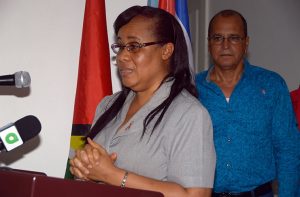– coordinator says centre has been growing and improving
FOREIGN Affairs Ministers from across the Caribbean, who are here for the Sixth Meeting of Foreign Ministers of CARICOM and Cuba, had an opportunity to tour the Regional Centre for Stimulating Children, Youth and Adolescents with Special Education Needs.
Permanent Secretary of the Ministry of Education, Adele Clarke, said the project idea was birthed at the fourth CARICOM-Cuba summit, with the aim of strengthening cooperation between CARICOM and Cuba.
This was then solidified at the fifth CARICOM-Cuba summit, where Guyana was selected as the country to take the lead role in its implementation.
At the local level, the Ministry of Public Health was tasked with the construction of the edifice which was completed in 2017, while the Ministry of Education was given the mandate for managing the operations.

“It should be noted, however, that although the centre is housed in Guyana, there is a regional focus in that CARICOM Member states would have access to training that will aid in improving the services offered by member states to persons with Special Education Needs,” said Clarke prior to the tour.
Coordinator of the Project, Keon Cheong, said the initiative of having a centre is a bold step in both helping to create the concept of the “ideal Caribbean person” as approved by CAIRCOM Heads of Government in 1997 and at the same time to address social justice issues.
“The centre has a number of objectives…these combined, outlines the passion and vision of improving the quality of life of persons with special education needs associated with disabilities in Guyana and the Region,” said Cheong.
Children, youth and adolescents are provided with evaluations that commences with observations, followed by in-depth interviews.
All of these actions aim to ensure that the assessment instruments selected are aligned with the individuals’ experience, culture and current circumstances in order to yield results that are both valid and reliable.
“But [the] process does not stop here at the centre, but transitions to the classroom and home where the concept of assessment drives instruction and intervention takes life and form,” said Cheong.
Parents and teachers participate in training, goal setting and identifying a time for achieving the identified goals.
Nationally and regionally, this facility provides the necessary data to chart the course of informing practices and policies.
In Guyana, Cheong said, they have started with the students in special schools to ensure that each one has an official diagnosis and identified support services.



.jpg)








